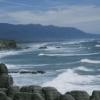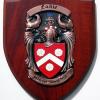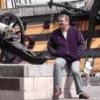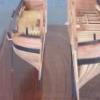MORE HANDBOOKS ARE ON THEIR WAY! We will let you know when they get here.
×
-
Posts
466 -
Joined
-
Last visited
Reputation Activity
-
 UpstateNY reacted to Emelbe in Revenge by Emelbe - Amati/Victory Models - 1/64 scale
UpstateNY reacted to Emelbe in Revenge by Emelbe - Amati/Victory Models - 1/64 scale
Back again with a quick update.
As I mentioned earlier in this log I aren’t really keen on the deck hatches and gratings, so I’ve decided to make my own as I’m leaning towards displaying the hatches without gratings so part of the lower decks can be seen. It’s not a massive job, but I think it’s worthwhile as it (in my opinion) enhances the appearance.
To do this I made a simple jig for setting the framing, especially as there is another the same size on the upper deck. To do this I set it out in SketchUp (3D CAD package) and printed it out. I then glued the drawing on to a piece of scrap board and framed around it using some spare strip. It’s just a matter then of building the hatch.
Before fitting I removed the beams which cross the opening and I added four support posts, which were a bit fiddly to position. I don't know if you can see them in the photo.
The ladders are pre milled and the treads are pre-cut to length, I’m not sure what wood they are but look nice when put together.
Next step is to glue the aft decks in place and then start work on the bow. I’ve actually got to page 9 in the manual now, only another 76 to go.
-
 UpstateNY reacted to Dan Vadas in HMS Vulture 1776 by Dan Vadas - FINISHED - 1:48 scale - 16-gun Swan-class sloop from TFFM plans
UpstateNY reacted to Dan Vadas in HMS Vulture 1776 by Dan Vadas - FINISHED - 1:48 scale - 16-gun Swan-class sloop from TFFM plans
Fish Davit
The Fish Davit is used when pulling up the Anchor. The associated tackle literally is used to "fish" the anchor around the flukes and then haul the crown end up ready for stowing.
The davit is tapered by 3 scale inches on all four sides. A stop is cut into each end :
A handrope is fitted to enable the davit to be manhandled into position. Nine eyestrops hold the two ropes together by passing through the centre of the davit. These were a whole lot of fun to fit, as they have an eye in one end and the other end doubles back into the hole. A drop of PVA glue holds the doubled end in place :
Danny
-
 UpstateNY reacted to CaptainSteve in USS Constitution by CaptainSteve - Model Shipways - 1:76.8 scale
UpstateNY reacted to CaptainSteve in USS Constitution by CaptainSteve - Model Shipways - 1:76.8 scale
Arrr ...
I be okay, CH, thanks fer askin'. Well, as OK as my therapist will attest to, anyways. The reason fer the long delay betwixt postings wouldst be that I has set meself three tasks to complete afore posting the details to me next log update. As of this most recent weekend, the biggest and hardest o' these tasks now be 80% completed.
-
 UpstateNY reacted to Mirabell61 in SS Kaiser Wilhelm der Grosse 1897 by Mirabell61 - FINISHED - scale 1:144 - POF - first German four stacker of the Norddeutscher Lloyd line
UpstateNY reacted to Mirabell61 in SS Kaiser Wilhelm der Grosse 1897 by Mirabell61 - FINISHED - scale 1:144 - POF - first German four stacker of the Norddeutscher Lloyd line
Many thanks Patrick and Mick,
and all the "like this" button activators...
Patrick,
Thanks for your appreciation, I took her off the board this afternoon and was delighted of the work so far, a straight symetric and light hull like it should be. All the overstanding frame hights will be removed (cut off) and the upper deck stringers put on. The slot places are integrated alrteady when I cut the frames
I am including some pics of this milestone moment....
Mick,
Thanks for your words ,..
For plating I shall use self-adhesive aluminium foil stripes which will be ponced from the rear side to resemble the riveting
Before the plating comes on, there is still some filler application work to be done, and several semi-round rails must be attached to the ouside hull skin.
removed from the board and put on the upper end-cap plank 180° around the stern.
Stb aft view...
stb front view
view into the aft ship hull. The outcuts for the deck stringers can be seen here
the "deck-beam" upper lnes are pre cut, so only the outer sides of the frames need to be cut. In this way the decks will have a positive curvature in width direction
one of the three lock-nut devices for the stand`s pedestal-spindles (through the keel and anchored in the "backbone" )
removing some old hardened glue drops out of the hull
-
 UpstateNY reacted to Mirabell61 in SS Kaiser Wilhelm der Grosse 1897 by Mirabell61 - FINISHED - scale 1:144 - POF - first German four stacker of the Norddeutscher Lloyd line
UpstateNY reacted to Mirabell61 in SS Kaiser Wilhelm der Grosse 1897 by Mirabell61 - FINISHED - scale 1:144 - POF - first German four stacker of the Norddeutscher Lloyd line
Build log part 10
bow post and vertical stern planking put on...
Nils
the upper portion of the stern rounding will be horizontal planking
The upper propshaft housings still need to be planked, and the whole stern area requires fairing and blending for smooth transitions afterwards
the bow post (beech wood) where the plates are riveted to later on, gives the nostalgic touch to the rather sharp bow
its time to take the hull off the board now....
-
 UpstateNY reacted to mattsayers148 in USS Ranger by mattsayers148 - FINISHED - Corel SM55 - 1:64 - 4th build, 2nd build log
UpstateNY reacted to mattsayers148 in USS Ranger by mattsayers148 - FINISHED - Corel SM55 - 1:64 - 4th build, 2nd build log
Nigel, CaptainSteve, George, Sam, Buck, Ken, Bob and Mark thank you guys for your kind and encouraging remarks. Thanks for the 'likes' as well.
I'm just a click away from the Optivisor. We're in the process of upsizing our living situation. I'm shooting for a room, shed corner of the garage, I want a space just for boat work. So when this happens I plan to do some upgrades to assist me before I break. Do you guys remember how I did the mortars? I blackened them and then ran a buffing wheel over them to blend off the darkness. This may be how I do it?
It kinda gave it an antique look. Also the shine seems to blur pics. Hey Cathead, thanks. Since my phone is my mobile computer that's always with me, I rarely get to see what a full screen looks like.
-
 UpstateNY got a reaction from Canute in USS Ranger by mattsayers148 - FINISHED - Corel SM55 - 1:64 - 4th build, 2nd build log
UpstateNY got a reaction from Canute in USS Ranger by mattsayers148 - FINISHED - Corel SM55 - 1:64 - 4th build, 2nd build log
Hi Matt,
Well you have 1c there already, but my 2c view is spectacular work by the entire Nutz team!
Cheers,
Nigel.
-
 UpstateNY got a reaction from src in USS Ranger by mattsayers148 - FINISHED - Corel SM55 - 1:64 - 4th build, 2nd build log
UpstateNY got a reaction from src in USS Ranger by mattsayers148 - FINISHED - Corel SM55 - 1:64 - 4th build, 2nd build log
Hi Matt,
Well you have 1c there already, but my 2c view is spectacular work by the entire Nutz team!
Cheers,
Nigel.
-
 UpstateNY got a reaction from thomaslambo in USS Ranger by mattsayers148 - FINISHED - Corel SM55 - 1:64 - 4th build, 2nd build log
UpstateNY got a reaction from thomaslambo in USS Ranger by mattsayers148 - FINISHED - Corel SM55 - 1:64 - 4th build, 2nd build log
Hi Matt,
Well you have 1c there already, but my 2c view is spectacular work by the entire Nutz team!
Cheers,
Nigel.
-
 UpstateNY got a reaction from GLakie in USS Ranger by mattsayers148 - FINISHED - Corel SM55 - 1:64 - 4th build, 2nd build log
UpstateNY got a reaction from GLakie in USS Ranger by mattsayers148 - FINISHED - Corel SM55 - 1:64 - 4th build, 2nd build log
Hi Matt,
Well you have 1c there already, but my 2c view is spectacular work by the entire Nutz team!
Cheers,
Nigel.
-
 UpstateNY got a reaction from CaptainSteve in USS Ranger by mattsayers148 - FINISHED - Corel SM55 - 1:64 - 4th build, 2nd build log
UpstateNY got a reaction from CaptainSteve in USS Ranger by mattsayers148 - FINISHED - Corel SM55 - 1:64 - 4th build, 2nd build log
Hi Matt,
Well you have 1c there already, but my 2c view is spectacular work by the entire Nutz team!
Cheers,
Nigel.
-
 UpstateNY got a reaction from mattsayers148 in USS Ranger by mattsayers148 - FINISHED - Corel SM55 - 1:64 - 4th build, 2nd build log
UpstateNY got a reaction from mattsayers148 in USS Ranger by mattsayers148 - FINISHED - Corel SM55 - 1:64 - 4th build, 2nd build log
Hi Matt,
Well you have 1c there already, but my 2c view is spectacular work by the entire Nutz team!
Cheers,
Nigel.
-
 UpstateNY got a reaction from mobbsie in Edme by mobbsie - FINISHED - 1/67 - RESTORATION - Thames Barge
UpstateNY got a reaction from mobbsie in Edme by mobbsie - FINISHED - 1/67 - RESTORATION - Thames Barge
HI Mobbsie,
Sorry to read of the accident to your lovely model and the "repairs" are certainly a bit of an eye opener! I love the stand and fact she now seems to "float" above the base.
I follow along on your repair build if you don't mind as you return her to her former glory.
Cheers,
Nigel.
-
 UpstateNY reacted to mattsayers148 in USS Ranger by mattsayers148 - FINISHED - Corel SM55 - 1:64 - 4th build, 2nd build log
UpstateNY reacted to mattsayers148 in USS Ranger by mattsayers148 - FINISHED - Corel SM55 - 1:64 - 4th build, 2nd build log
Well this little windlass is taking awhile so I'm doing an update of the weeks adventures.
First on the agenda was to move the windlass back 12inches. I won't say who(Harry), but no room was left for the samson post which has the pawl and hand pump assembly.
The pawl was made by soldering three brass strips that extended through a small, rectangled brass stock. The pivot arm was attached atop the samson post and fitted with links to attach to the purchase arms.
Next, the purchase arms were made from thin brass tubing and were beaten into submission. Solid brass rods were inserted into the ends to accept more links. Finally, the purchase arm were attached to the rear of the windlass with a tiny pin nail and secured with a drop of CA.
After much painful eye straining, final adjustments were made and the links were joined together. Next was making the detachable pump handles. While there was wood being turned, I made a couple of belaying pins to check for fit and appearance.
In this trial fit of the handles, they proved to be too short. So extensions were added to the handles to achieve the desired length.
Everything fit well in the end, even the first of many belaying pins.
This picture shows the handles in the up and down position, which are the only moving parts to the windlass.
Here's a penny for reference. I still plan to add whipping to the handles and a bracket on the front of the samson post to hold the handles when not in use. Also in debate is blackening or not. Might be awhile before that's figured out.
-
 UpstateNY reacted to NenadM in Cutty Sark by NenadM
UpstateNY reacted to NenadM in Cutty Sark by NenadM
Thanks Mark and Marc.
There is an interesting thing I was thinking of. If you succeeded in something miniature, on some way, to me it seems that, success in some way pin you down to keep that line of detailing. It does not matter that you need a magnifier to see something. I thing that "invisible" details gives something special in whole picture on the similar way as high range of frequencies gives special feeling to music you listen
Usual Saturday ... garden work at morning and after lunch fight with Yuka, and after that, nice time in shipyard at the evening
First decided to finish right cat-head with whisker boom - complete done. I decided to put on it all possible shackle I am able to make, so, I started to play with beats ( brass wire 0,5 mm in 0,5 mm holes cemented with CA and covered with black acrylic
First - whisker. Two angles ( to up and to the back) are presented, and I tried to follow angles on C-plans
Temporary in place
And a details of connection.
Then .... uh how small are this ... very hard to control them ... making
Dry testing
It can not pass through the hole I made, so it have to be mounted later
And then I decided to try one nice detail, which is, I suppose, necessary for proper rigging of bowsprit ( on C-plans called "Eyebair for Fore Tuck")
Little improvisation ( wire goes through sheave) and here we are. here are cleat, pins on both side of cat-head, and "cat-stopper" (?)
Uh, oh, ah, it seems I forgot to extend "cat-stopper" through bullwark to the outside on the fore surface of cat ... something to do next time, but it will be difficult, considering everything is cemented
Ok, cathead is cemented on place, and there is time to put beats/beasts on their place. There is something in C-plans called "Iron horn", but there simply has no place for it, considering whiskers are a bit over-scale thick
Hmmm ... little overscaled, but I can live with this
And after painting
And whole look of cat head with mounted whiskers boom
Edit: previewing post I noticed that I mixed pictures and text, but, i think you get a point. One of this days I ll edit this post properly. To late now
-
 UpstateNY got a reaction from mtaylor in Edme by mobbsie - FINISHED - 1/67 - RESTORATION - Thames Barge
UpstateNY got a reaction from mtaylor in Edme by mobbsie - FINISHED - 1/67 - RESTORATION - Thames Barge
HI Mobbsie,
Sorry to read of the accident to your lovely model and the "repairs" are certainly a bit of an eye opener! I love the stand and fact she now seems to "float" above the base.
I follow along on your repair build if you don't mind as you return her to her former glory.
Cheers,
Nigel.
-
 UpstateNY reacted to catopower in Yakatabune by Catopower - FINISHED - Woody Joe - 1/24 scale - Small
UpstateNY reacted to catopower in Yakatabune by Catopower - FINISHED - Woody Joe - 1/24 scale - Small
Now, getting back to boat construction. The deck planking is complete since the center section is the area for the deck house.
The next step is to cut and fit the beams. On a real traditional Japanese boat, the beams would be mortised into place. On the model, they're not really structural members and just glue in place in the laser cut notches of the upper planks. If the upper planks were mounted too low, the beams wouldn't fit properly as there is little clearance for them once the deck planks are installed.
The beams are among the included strip wood supply, so they have to be cut to length. This was a good opportunity for me to use the Japanese hobby saw I got from Zootoys. The saw isn't cheap, but if you're buying a kit from Japan, it shouldn't add much to the shipping cost since it's so light.
This is the first Japanese saw I've owned and it is a treat to use. Unlike Western saws, Japanese saws cut on the pulling stroke. This keeps the cut very straight and allows the saw to be very thin. This is, in fact, the thinnest hobby saw I've ever seen at only 0.1mm thick. All in all, the cuts are very straight, very quick, and very clean.
This photo may make the saw look a lot bigger than it really is. It's just under 8" long and is very light weight.
Anyway, cutting and fitting the beams was very simple. The short beams were a bit more of a challenge since the inside edge is sanded flush.
Below, you can see how the battery cover section of the deck is left so that it can slide in and out of place. I recommend removing this section while working on steps 13 and 14 to better avoid accidentally gluing it into place.
Note that all the photos show the caprail in place. That's actually step 14. Basically, full length strips are shaped to fit at the stem, but the won't be long enough to reach the full length of the boat. At the aft end then, short pieces are put into place. The caprail fits so that the inner edge is flush with the hull planking.
This is a very straightforward part of the build.
Roughly Translated Text (some of this required a little more interpretation to make sense):
Step 13 Installation of Beams
• Cut and install 17 to dimensions shown and install.
Short beams should be mounted flush with the inside of the hull planking
Cut a part 18 to fit the laser cut area at the bow deck as illustrated.
Fit of short beams on starboard side is the same as on the port side.
One line I can't quite translate exactly, but can only interpret.
On Bing Translate it comes out as:
"3 mm difference between narrow the scope"
On Google it comes out as:
"3 mm Masu Plug"
What do either of these mean? This is a straight forward step where a 2mm hole is drilled in either end of a beam and a 12mm long dowel piece is fit into them. The exact positions can be viewed on the plans. The only thing that I can figure about the “3 mm” reference is that 3 mm of the dowels will fit into the beam.
I should point out that Bing seems to translate better than Google – At least for Japanese text.
The above text makes more sense with the instructions illustrations. Again, with permission from Woody Joe.
Step 14 Installation of Deck Edge (Caprail)
Bend pieces to shape of hull.
Please add short sections at stern. (Japanese instructions are quite polite and often say "please")
Align inside edges of rail to inside of hull.
The model is looking more like a traditional Japanese boat now and I'm really finding that I am enjoying this build perhaps even more than the last one, which had sails and oars. This one, somehow feels culturally significant, if that makes sense.
Clare
-
 UpstateNY reacted to catopower in Yakatabune by Catopower - FINISHED - Woody Joe - 1/24 scale - Small
UpstateNY reacted to catopower in Yakatabune by Catopower - FINISHED - Woody Joe - 1/24 scale - Small
Glad to be of some help, Bob. Heck, your build helped inspire me many times, so I'm glad to return the favor!
Well, the last couple of days, my brain has just been all fuzzy. I'm not in a ship modeling rut, just a general rut. Looking forward to our local gathering of forum ship modelers in Vallejo tomorrow. Maybe that will wake up my brain a little.
Am managing this post, though, so I guess I'm not totally fried...
Okay, so about that walkway platform. The kit instructions translate this to either railing or parapet. I'll just call it railing. Here's the translation I worked out from the instructions for this step:
Step 15 Installation of Railing, Part 1•Refer to the plans in the installation of the walkway.
Cut (planks ends) flush with the edge of the beams
Trim off the protruding ends of the beams
This step requires a little soaking and bending of wood strips. Again, definitely wet the wood thoroughly before trying to bend it. Bends very nicely when wet, no heat required.
Walkway planks added.
Closeup of the walkway planks. You can see the beam sticking out a little at lower left that will need to get trimmed flush with the planking. Also, I think you can make out that the outer planks here are the L-shaped ones. This creates a little lip against which the posts of the side railing fits against.
Carrying on to complete the rail installation...
Step 16 Installation of Railing, Part 2• Please assemble the handrails according the full size diagrams.
Mount the railing to fit up against the lip
With pre-cut parts for the rail stanchions, this step is pretty simple. It just requires a little pre-bending of the rails themselves, and the stanchions should be kept vertical, so they aren't all perpendicular to the rails themselves.
Rails assembled according to the full-size plan sheets
The stanchions aren't pegged in, just glued. I'm using Titebond, so I want to clamp them firmly in place until glue sets
Both rails now in place
Closeup of the rail detail.
It's at this point that I really started to look at this model as a really nice example of a very Japanese boat. The concept of the pleasure boats with several people out on the water for an evening and watching fireworks over the river on a warm summer night is a very charming image.
In a previous post, I mentioned Japanese lanterns. Then, the person who suggested them had a though about how maybe these standing floor lanterns might not have been used by a boat that might rock and they might tip over, which I really did wonder about. Then, I spoke with my Japanese music teacher (I have been a student of the Japanese 3-stringed lute called a "Shamisen" for about 10 years now), who used to live in Asakusa, which is a part of Tokyo with a traditional Edo period theme (well, that and lots of old style shopping).
As far as Japanese people go, my teacher is pretty connected with traditional culture and she's been interested in my traditional Japanese boats, but especially the Yakatabune. I think it's a real cultural symbol of "the good life" and very important to many people when they think about it.
Anyway, I mentioned the lantern to her and about the possibility that they might have had to use hanging lanterns because it was in a boat. She pretty confidently dismissed that idea. I guess the idea is that floor lanterns were classy and the hanging ones, not so much, except outdoors. Probably the boatmen worked pretty hard to not rock the boat.
Thinking about it, it's not like there were any power vessels at the time to create big wakes, so not much reason for a decent sized boat to rock. So, I'm sticking with the floor lanterns idea, which I'm really glad about.
Clare
-
 UpstateNY reacted to Emelbe in Revenge by Emelbe - Amati/Victory Models - 1/64 scale
UpstateNY reacted to Emelbe in Revenge by Emelbe - Amati/Victory Models - 1/64 scale
Hi All,
Once again many thanks for your comments.
I’ve set to work on building the keel and bulkheads. The first job was to check the fit of the bow, and keel pieces which, as expected, were perfect. Another little job was to make an aid for planking the bow, which is simply to cut out the area of the bow from the MDF sheet, glue two pieces either side which slightly overlap the curve of the bow forming a slight lip, which will then be temporarily screwed to the bow to form a rabbet for planking. Hopefully this will cut out the need for using small nails to hold the planks in place. I’ve added a couple of images as a picture tells a thousand words.
So it’s on to the trusty old building board, nothing fancy, just a side from an old MDF unit with four ‘L’ brackets. Bye the way, if anyone’s interested the two strips are for holding stripwood while sanding their edges.
When fitting bulkheads I always start amidships and work forward and aft checking for square as I go. As I mentioned earlier the whole hull is fairly self aligning so no great problems there. Before I glue the bulkheads in place I roughly profile them using my Dremel.(I’ve yet to fit the three stern ones)
The main gun-deck required a little tweaking to sit properly, which I think was due to Frame 4 (from the bow) being too low. Fortunately I spotted this and took a measurement from the drawings and set its height from there. There being a lesson learned, fortunately in time, the manual is so self explanatory I almost forgot the drawings. They’re now pinned up on the wall so I can’t miss them!
The gun deck is in two halves and the manual indicates planking off the model and then fitting, but the pictures of the deck in situ show quite a distinct irregularity, for want of a better word, where they are joined once the decks are fitted. I know you can’t see much of the gun-deck once the upper deck is in place, but this would drive me mad (it’s a personal thing). Anyway, for that reason I fitted the gun-deck and then planked it after.
Now, I don’t think this has ever happened to me before, the planks ended up absolutely symmetrical about the centre line, this is not a testimony to my planking, but to the accuracy of the laser cut parts included in this kit, I’m not sure if you can see it in the photograph below.
So, for the time being I’m all planked out, time for some respite and on with the deck hatch framing and ladders.
Cheers
Martin
-
 UpstateNY reacted to mrangus in Scottish Maid by mrangus - Artesania Latina - first build
UpstateNY reacted to mrangus in Scottish Maid by mrangus - Artesania Latina - first build
So of course I finally put a little oil on the channels and once dried glued the deadeyes into the channel slots... and THEN I finally noticed that the small deadeye was on the wrong side!! So I had to remove #2 and #4 and switch them. After much angst and a few curse words, I got it done - I think it actually looks a little better....
One funny story. I was putting the aforementioned cleat onto the boat using a pair of tweezers, and ptewey! I squeezed a little too hard and it went flying.... somewhere.... It took me over a half hour to carve that little bugger so I wasn't about to start over. I looked *everywhere*, had to clean off the bench, went through all the stuff around my bench, couldn't find it, and finally gave up. Only to notice it was sitting right on the deck the whole time. At least I cleaned up a bit - see before/after pics.
And I figured out the image issue! Drag-n-drop works! (sort of... just thumbnails, not the full-size pic.)
-
 UpstateNY reacted to mrangus in Scottish Maid by mrangus - Artesania Latina - first build
UpstateNY reacted to mrangus in Scottish Maid by mrangus - Artesania Latina - first build
I worked on the lifeboat some more, cleaned it up to the point where I'm comfortable with it. Not entirely, but enough so to move on. In thinking about how the boat would be installed on the ship, it bothered me that they wanted the lashing tied to the loops on the boat's platform. I thought it would be more appropriate for the rope to be lashed to a cleat, so I attempted to make a cleat for this purpose. The images show the progress:
(btw I still can't figure out how to 'insert' images in my typing area. cut/paste doesn't work, the 'image' button doesn't work, I don't see other options.)
How are coils made? I thought it would be cool to coil the rest of the rope, but not sure where to begin with that. and the rope is a bit finicky... maybe make the coil beforehand, and then lash?
-
 UpstateNY reacted to Mirabell61 in SS Kaiser Wilhelm der Grosse 1897 by Mirabell61 - FINISHED - scale 1:144 - POF - first German four stacker of the Norddeutscher Lloyd line
UpstateNY reacted to Mirabell61 in SS Kaiser Wilhelm der Grosse 1897 by Mirabell61 - FINISHED - scale 1:144 - POF - first German four stacker of the Norddeutscher Lloyd line
Little update....
the last plank for the hull was put on today, and the outside skin first faired with a viratory sander because due to the accumulated overload of the postworkers strike I still did`nt get that ordered spokeshave...
Nils
next, is to put on the bow post, straight stem and around the bend to the keel in bow area. I think I`ll take it off the "slip-way" then and plank the upper stern bulwark area vertically
-
 UpstateNY got a reaction from Dimitris71 in Red Dragon by UpstateNY - FINISHED - Artesania Latina - Scale 1:60
UpstateNY got a reaction from Dimitris71 in Red Dragon by UpstateNY - FINISHED - Artesania Latina - Scale 1:60
Hi All,
Janet's mention in her post above that she is rigging her tiller reminded me I also needed to assemble the rudder and tiller as I am getting pretty close to no longer being able to easily invert my Dragon.
I had previously made up the rudder assembly by planking and tree nailing the laser cut former and making up the post using 5mm walnut strips. The tiller was a laser cut part so after cleaning off the char, I drilled out a recess using my Dremel so I could attach the rudder assembly. I added a small walnut piece to the top of the tiller to simulate a through tenon for the rudder post. Brass was used to form the tiller posts for the rigging as well as the larger rod that supports the rudder on the deck. Just for fun, I also added a brass rod to "pin" the tenon. Test assembly showed everything seems to fit OK so I just need to blacken the brass and give the wood a coat of poly before gluing everything in place.
Thumbnails below...thanks for reading.
Cheers,
Nigel.
-
 UpstateNY got a reaction from mrangus in Scottish Maid by mrangus - Artesania Latina - first build
UpstateNY got a reaction from mrangus in Scottish Maid by mrangus - Artesania Latina - first build
Hi Robb,
Your build looks great and I am amazed at how fast you are moving!
Enjoy your vacation!
Cheers,
Nigel.
-
 UpstateNY got a reaction from dgbot in Red Dragon by UpstateNY - FINISHED - Artesania Latina - Scale 1:60
UpstateNY got a reaction from dgbot in Red Dragon by UpstateNY - FINISHED - Artesania Latina - Scale 1:60
Hi All,
Janet's mention in her post above that she is rigging her tiller reminded me I also needed to assemble the rudder and tiller as I am getting pretty close to no longer being able to easily invert my Dragon.
I had previously made up the rudder assembly by planking and tree nailing the laser cut former and making up the post using 5mm walnut strips. The tiller was a laser cut part so after cleaning off the char, I drilled out a recess using my Dremel so I could attach the rudder assembly. I added a small walnut piece to the top of the tiller to simulate a through tenon for the rudder post. Brass was used to form the tiller posts for the rigging as well as the larger rod that supports the rudder on the deck. Just for fun, I also added a brass rod to "pin" the tenon. Test assembly showed everything seems to fit OK so I just need to blacken the brass and give the wood a coat of poly before gluing everything in place.
Thumbnails below...thanks for reading.
Cheers,
Nigel.












